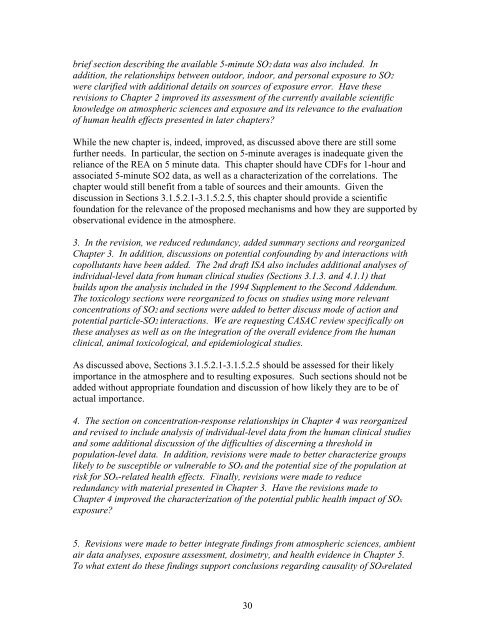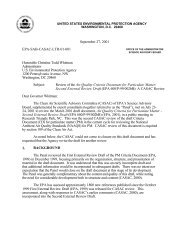(CASAC) Peer Review of EPA's Integrated Science Assessment
(CASAC) Peer Review of EPA's Integrated Science Assessment
(CASAC) Peer Review of EPA's Integrated Science Assessment
Create successful ePaper yourself
Turn your PDF publications into a flip-book with our unique Google optimized e-Paper software.
ief section describing the available 5-minute SO2 data was also included. Inaddition, the relationships between outdoor, indoor, and personal exposure to SO2were clarified with additional details on sources <strong>of</strong> exposure error. Have theserevisions to Chapter 2 improved its assessment <strong>of</strong> the currently available scientificknowledge on atmospheric sciences and exposure and its relevance to the evaluation<strong>of</strong> human health effects presented in later chapters?While the new chapter is, indeed, improved, as discussed above there are still somefurther needs. In particular, the section on 5-minute averages is inadequate given thereliance <strong>of</strong> the REA on 5 minute data. This chapter should have CDFs for 1-hour andassociated 5-minute SO2 data, as well as a characterization <strong>of</strong> the correlations. Thechapter would still benefit from a table <strong>of</strong> sources and their amounts. Given thediscussion in Sections 3.1.5.2.1-3.1.5.2.5, this chapter should provide a scientificfoundation for the relevance <strong>of</strong> the proposed mechanisms and how they are supported byobservational evidence in the atmosphere.3. In the revision, we reduced redundancy, added summary sections and reorganizedChapter 3. In addition, discussions on potential confounding by and interactions withcopollutants have been added. The 2nd draft ISA also includes additional analyses <strong>of</strong>individual-level data from human clinical studies (Sections 3.1.3. and 4.1.1) thatbuilds upon the analysis included in the 1994 Supplement to the Second Addendum.The toxicology sections were reorganized to focus on studies using more relevantconcentrations <strong>of</strong> SO2 and sections were added to better discuss mode <strong>of</strong> action andpotential particle-SO2 interactions. We are requesting <strong>CASAC</strong> review specifically onthese analyses as well as on the integration <strong>of</strong> the overall evidence from the humanclinical, animal toxicological, and epidemiological studies.As discussed above, Sections 3.1.5.2.1-3.1.5.2.5 should be assessed for their likelyimportance in the atmosphere and to resulting exposures. Such sections should not beadded without appropriate foundation and discussion <strong>of</strong> how likely they are to be <strong>of</strong>actual importance.4. The section on concentration-response relationships in Chapter 4 was reorganizedand revised to include analysis <strong>of</strong> individual-level data from the human clinical studiesand some additional discussion <strong>of</strong> the difficulties <strong>of</strong> discerning a threshold inpopulation-level data. In addition, revisions were made to better characterize groupslikely to be susceptible or vulnerable to SOx and the potential size <strong>of</strong> the population atrisk for SOx-related health effects. Finally, revisions were made to reduceredundancy with material presented in Chapter 3. Have the revisions made toChapter 4 improved the characterization <strong>of</strong> the potential public health impact <strong>of</strong> SOxexposure?5. Revisions were made to better integrate findings from atmospheric sciences, ambientair data analyses, exposure assessment, dosimetry, and health evidence in Chapter 5.To what extent do these findings support conclusions regarding causality <strong>of</strong> SOxrelated30
















